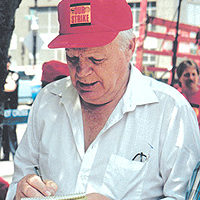After 11 months of stalling, the Energy Department grudgingly agreed to a court order and on March 26 released 11,000 pages of documents showing collusion between the nation’s energy conglomerates and the White House in the formation of the Bush administration’s energy policy.
The documents in question came from several government departments, including the Department of Energy and the Office of Management and Budget (OMB). Vice President Richard Cheney has refused to hand over another 15,000 pages of documents sought by environmental and consumer organizations.
A first review of the material bolsters the contention that the Bush administration relied almost exclusively on the advice of executives from utilities and producers of oil, gas, coal and nuclear energy while a White House task force drafted the Bush administration’s energy program. Even though the text of many pages was completely blacked out, they show that Energy Secretary Spencer Abraham gave business interests and campaign contributors a ringside seat to the deliberations while leaving environmental groups and consumer advocates standing outside the door.
A New York Times article says Abraham met with representatives of at least 20 energy corporations and trade associations last year. Together, they gave more than $4.1 million to Republicans from 1999 to 2001. Democrats, the article notes, received at least $1.7 million over that period from the same sources.
The list of Abraham’s guests includes representatives from the National Association of Manufacturers, the Independent Petroleum Association of America and the Nuclear Energy Institute. The Secretary also played host to high-ranking executives from Westinghouse Electric, Duke Power, the American Coal Company and Enron.
Because of the deletions and omissions, there is little information about what the donors and business interests were seeking in their high-level meetings.
Following release of the documents, Abraham called the National Energy Policy “balanced and comprehensive,” adding: “The information contained in the documents … will only further confirm that it was indeed a balanced plan that not only sought but included all viewpoints.”
In the statement Abraham repeated the often-told tale that the administration’s plan shared 11 of 12 energy proposals put forward by the Sierra Club, a statement denied by a Sierra Club media spokesperson. “That’s absolutely inaccurate,” Nat Garret said in a telephone interview. “If Abraham thinks that they included 11 of 12 of our recommendations, he must have an auditor from Arthur Andersen doing the math.”
Larry Klayman, chairman of Judicial Watch, the watchdog group that won the court order requiring the OMB, Environmental Protection Agency and Department of Agriculture releases, said the White House appeared to be “playing games” with the release. He said he expects to “go back to court to seek testimony as to why we don’t have the substantive e-mails.”
Several of the documents indicate that officials were aware of efforts to obtain information about their actions under the Freedom of Information Act, and they adjusted their correspondence to limit the release of materials. “We have an FOI [Freedom of Information] request for all NEPP [National Energy Policy] material,” said one April 25 e-mail, referring to the task force. “Keep in mind that whatever I get I will have to include with it.”
Abraham’s staff had several meetings with Enron officials, the documents showed. Enron, a major Bush donor that collapsed late last year and is facing a criminal probe, met with other representatives of the task force six times, the administration has disclosed. Energy Department officials said most of their meetings with Enron were not related to the energy policy. Abraham met with two Enron executives on March 29, 2001 as part of a meeting of 16 industry officials about the California electricity shortage.
The OMB documents indicate Bush was involved in the shaping of the report well before it was released May 16. The task force briefed him on March 19, a schedule indicates, and a final report was circulated on April 23. The OMB materials that were released also indicate the energy task force’s emphasis on production over conservation.
Bush’s energy plan encourages increased production of fossil fuels, including relaxed regulations and subsidies for the coal and nuclear industries, oil and gas drilling in the Arctic National Wildlife Refuge and construction of 1,300 to 1,900 power plants over the next 20 years. Most of Bush’s energy recommendations were incorporated in a bill that passed the House in August. The Senate has begun debating its version and is expected to take up the most controversial part, the Arctic drilling, when lawmakers return from recess in two weeks.
The author can be reached at fgab708@aol.com









Comments